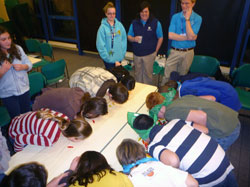This activity is designed to demonstrate how striped bass larvae feed on copepods, their zooplankton prey and how larvae are preyed upon by bigger fish. Four scenarios are investigated in this activity: larvae feeding on abundant copepods within the ETM, larvae feeding on scarce copepods outside the ETM, predators capturing larvae in the dark ETM, predators capturing larvae outside the ETM. Students will hypothesize which conditions most closely represents those found in the ETM nursery area of the Chesapeake Bay and which scenarios are most favorable for striped bass larvae survival.
Teacher Note: All "Engage" activities may be completed in one class period or presented as the content is discovered in the web resource. This activity takes approximately 15 minutes if you have your tables and marshmallows counted and distributed ahead of time.
Objectives
- Identify predator-prey relationships found in the ETM nursery area
- Demonstrate striped bass larvae feeding behavior
- Hypothesize which feeding conditions most closely match those found in the ETM of the Chesapeake Bay
Materials
- Saran wrap
- Mini marshmallows
- Gummy fish candy
- Blindfolds/bandanas
- Clip boards
- Data Collection Sheets
- Student volunteers
- Data Table
Procedure
You will need a minimum of 8 volunteers but could be extended to 16 or 24 depending on your space and number of students in class.
- Four students will role play the striped bass larvae and 4 students will be the data collectors. (Place a data table on an overhead projector to record the data for all students to see)
- Cover desks in saran wrap.
- Place 10 mini marshmallows on 2 desks and 100 mini marshmallows on 2 desks. (Use more desks if utilizing more students.) Marshmallows represent copepods, food for striped bass larvae. The desks with 100 marshmallows represents the ETM, where prey abundance is high. The desks with 10 marshmallows represents habitat outside the ETM, where prey abundance is low.
- Each of the four volunteers are now “striped bass larvae.” Two need to be blindfolded (represents the dark ETM area) while the other two are not blindfolded (represents an clear area outside the ETM nursery area). It is better if the students acting as larvae cannot see the conditions that they will feed in, so send these students outside the room during set up.
- Allow the blindfolded/not blinkfolded student volunteers to position themselves at their feeding stations.
- Since striped bass larvae hatch with no fins, students will not be permitted to use their hands to feed. Students can only use their mouths.
- Using a stopwatch, allow the fish to feed for 20 seconds.
- The data recorder counts home many marshmallows are consumed. Data is posted on an overhead for all to see.
Condition:striped bass larvae feeding | Dark 100 | Light 10 |
# marshmallows eaten
|
|
|
- Change the scenario to demonstrate which condition (dark ETM or light outside ETM) is better for larvae hiding from predators. Now the students are predators of the larvae (any fully grown fish).
- Lay out 20 gummy fish on each desk. The gummy fish represent striped bass larvae. Blindfold half the predators to simulate feeding inside the ETM. The predators who are not blindfolded are feeding outside the ETM.
- Students can feed by picking up the fish with their hands (larger fish can now actively seek out and capture their prey).
- Using a stopwatch, allow the fish to feed for 20 seconds.
- The blindfolded students should catch less larvae that those not blindfolded, demonstrating that larvae have a better chance of hiding from predators in the ETM.
- The data recorder counts home many gummy fish are consumed. Data is posted on an overhead for all to see.
Condition: predator feeding | Dark 20 | Light 20 |
# gummy fish eaten
|
|
|
- From the data, determine which combination of conditions is the best for striped bass larvae survival.
- Follow with a discussion about which conditions most closely resemble those found in the Chesapeake Bay. (Students should conclude that the dark condition with 100 marshmallows represents the ETM nursery area. The ETM is dark, so the larvae have a better chance of escaping predators and there is also an abundance of food.)
National Science Education Standards
9-12 A: Science as Inquiry
- Understandings about scientific inquiry
9-12 C: Life Science
- Interdependence of organisms
- Matter, energy, and organization in living systems
- Behavior of organisms